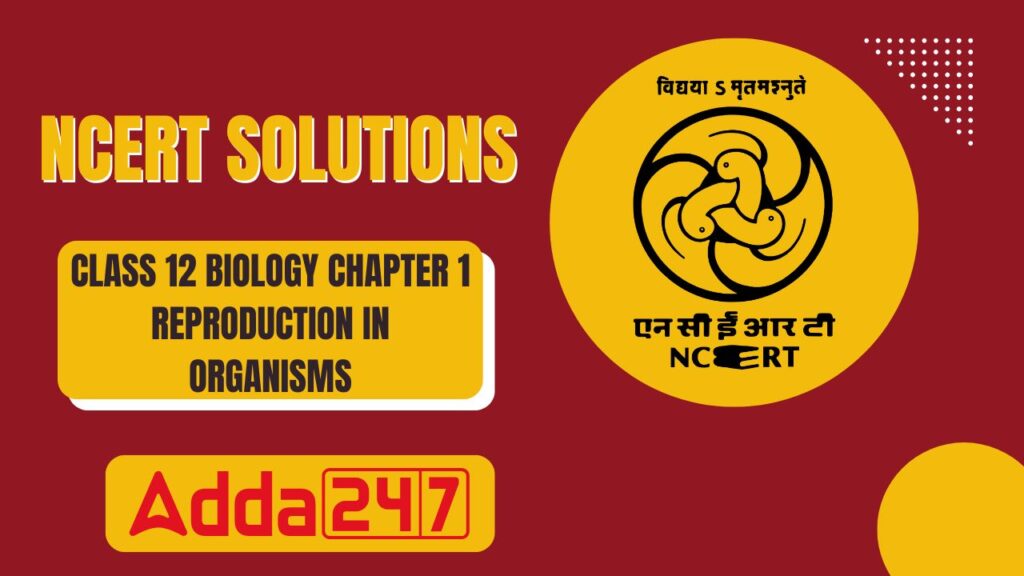
Reproduction is a biological process of producing offspring for the continuation of the species. This is a necessity for the survival of any species or life on the planet. The chapter 1 in the NCERT Class 12 Biology textbook goes about the study of Reproduction in Organisms. This chapter highlights studies about crucial topics like types, modes, and processes of reproduction, emphasizing the differences between asexual and sexual reproduction, their significance, and associated events like gametogenesis, fertilization, and post-fertilization changes.
Overview of CBSE Class 12 Biology Chapter 1
The Chapter 1 in the CBSE Class 12 Biology Syllabus revolves around the various studies and theories regarding Reproduction in Organisms. Below, we have shared an overview of what students are to study in this chapter:
- Importance of Reproduction: Why reproduction is essential for species survival and evolution.
- Types of Reproduction:
- Asexual Reproduction: Involves a single parent, producing genetically identical offspring (clones).
- Sexual Reproduction: Involves two parents, fusion of male and female gametes, leading to genetic variation.
- Modes of Reproduction:
- Asexual: Binary fission, budding, fragmentation, vegetative propagation, etc.
- Sexual: Gamete formation, fertilization (external and internal), and embryonic development.
- Life Phases: Juvenile phase, reproductive phase, and senescent phase.
- Reproductive Structures: Zoospores, zygotes, gametes, and their roles.
- Pre-fertilization and Post-fertilization Events: Gametogenesis, pollination, fertilization, embryo development, and seed formation.
- Special Cases: Bisexual flowers, external fertilization, vegetative propagation, and parthenogenesis.
NCERT Solutions for Class 12 Biology Chapter 1 Reproduction in Organisms
To help students complete their preparations for the final examination of the Biology subject in class 12th we have added the NCERT Solutions for Class 12 Biology Chapter 1 Reproduction in Organisms below:
Question 1: Why is reproduction essential for organisms?
Answer: Reproduction is essential for organisms because it ensures the continuity of their species across generations. Every organism has a finite lifespan, and without reproduction, species would become extinct. Reproduction allows organisms to produce offspring that inherit their genetic material, maintaining the species’ existence. Additionally, reproduction introduces genetic variations (especially in sexual reproduction), which are crucial for adaptation to changing environments and for evolution.
Question 2: Which is a better mode of reproduction: sexual or asexual? Why?
Answer: Sexual reproduction is considered a better mode than asexual reproduction for the following reasons:
- Genetic Variation: Sexual reproduction involves the fusion of male and female gametes from two parents, leading to genetic recombination and variation in offspring. This variation enhances adaptability to environmental changes and supports evolution.
- Survival Advantage: Offspring with diverse genetic makeup have better chances of surviving unfavorable conditions compared to genetically identical offspring from asexual reproduction.
- Evolutionary Potential: Variations introduced through sexual reproduction drive natural selection, contributing to the evolution of species. However, asexual reproduction is advantageous in stable environments due to its simplicity and speed, as it requires only one parent and no gamete fusion. The choice depends on environmental conditions, but sexual reproduction is generally superior for long-term survival and evolution.
Question 3: Why is the offspring formed by asexual reproduction referred to as a clone?
Answer: Offspring formed by asexual reproduction are called clones because they are morphologically and genetically identical to the parent. Asexual reproduction involves a single parent and does not involve gamete fusion or genetic recombination. The offspring are produced through processes like mitosis, resulting in exact genetic copies of the parent, hence termed clones.
Question 4: Offspring formed due to sexual reproduction have better chances of survival. Why? Is this statement always true?
Answer: Offspring from sexual reproduction have better chances of survival because:
- Genetic Diversity: The fusion of male and female gametes introduces genetic variation through recombination and random segregation of chromosomes, enabling offspring to adapt to changing environments.
- Adaptability: Variations allow some offspring to possess traits that enhance survival under stress, such as resistance to diseases or environmental changes.
- Evolutionary Advantage: Genetic diversity supports natural selection, increasing the likelihood of species survival over time.
Is the statement always true? No, it is not always true. In stable environments, asexual reproduction may be more advantageous because it produces genetically identical offspring quickly, ensuring survival in consistent conditions. However, in changing or unpredictable environments, sexual reproduction’s genetic diversity provides a survival edge.
Question 5: How does the progeny formed from asexual reproduction differ from those formed by sexual reproduction?
Answer:
| Aspect | Asexual Reproduction |
Sexual Reproduction
|
| Parent Involvement | Single parent |
Two parents (male and female)
|
| Genetic Makeup | Genetically identical to the parent (clones) |
Genetically diverse due to recombination
|
| Process | Involves mitosis, no gamete fusion |
Involves meiosis and gamete fusion
|
| Variation | No genetic variation |
High genetic variation
|
| Examples | Binary fission in Amoeba, budding in Hydra |
Fertilization in humans, pollination in plants
|
Explanation: Asexual reproduction produces offspring that are exact copies of the parent, lacking variation, while sexual reproduction results in genetically diverse progeny due to crossing over, random segregation, and fertilization.
Question 6: Distinguish between asexual and sexual reproduction. Why is vegetative reproduction also considered a type of asexual reproduction?
Answer:
| Feature | Asexual Reproduction |
Sexual Reproduction
|
| Number of Parents | Single parent | Two parents |
| Gamete Formation | No gamete formation |
Involves formation and fusion of gametes
|
| Genetic Variation | No variation; offspring identical to parent |
High variation due to genetic recombination
|
| Cell Division | Involves mitosis |
Involves meiosis and fertilization
|
| Speed | Faster, requires less energy |
Slower, energy-intensive
|
| Examples | Budding in yeast, fragmentation in Spirogyra |
Human reproduction, flowering plant pollination
|
Question 7: Why is vegetative reproduction considered asexual?
Answer: Vegetative reproduction is a type of asexual reproduction because:
- It involves a single parent.
- No gamete formation or fusion occurs.
- Offspring are produced from vegetative parts (e.g., stems, roots, leaves) and are genetically identical to the parent, similar to other asexual methods like budding or fission.
Question 8: What is vegetative propagation? Give two suitable examples.
Answer: Vegetative propagation is a form of asexual reproduction in plants where new individuals are produced from vegetative parts (e.g., stems, roots, leaves) without involving seeds or spores. It results in genetically identical offspring.
Examples:
- Potato Tubers: The “eyes” or buds on potato tubers grow into new plants under favorable conditions.
Bryophyllum Leaves: Adventitious buds on the leaf margins of Bryophyllum develop into new plants when they fall to the ground.
Question 9: Define (a) Juvenile phase, (b) Reproductive phase, (c) Senescent phase.
Answer:
- (a) Juvenile Phase: The period from birth to the onset of reproductive maturity, during which an organism grows and develops but is not yet capable of reproduction. For example, in humans, this is the pre-pubertal stage.
- (b) Reproductive Phase: The period when an organism is sexually active and capable of producing offspring. It involves the development of secondary sexual characteristics and gamete production. For example, in humans, this begins at puberty.
(c) Senescent Phase: The phase following the reproductive phase, characterized by a decline in physiological functions, slowing of metabolism, and eventual death due to aging. For example, in humans, this is the post-reproductive elderly stage.
Question 10: Higher organisms have resorted to sexual reproduction in spite of its complexity. Why?
Answer: Higher organisms prefer sexual reproduction despite its complexity because:
- Genetic Variation: It results in offspring with diverse genetic combinations due to the fusion of gametes from two parents, enhancing adaptability to environmental changes.
- Survival Advantage: Genetic diversity increases the chances of survival in adverse conditions, as some offspring may inherit traits that confer resistance to diseases or environmental stress.
Evolutionary Benefit: Variations drive natural selection, leading to the evolution of species and adaptation to new ecological niches.
Question 11: Explain why meiosis and gametogenesis are always interlinked?
Answer: Meiosis and gametogenesis are interlinked because:
- Gametogenesis: This is the process of forming gametes (sperm and egg) in sexually reproducing organisms.
- Meiosis: This is the type of cell division that reduces the chromosome number by half, producing haploid gametes from diploid parent cells. In sexually reproducing organisms, gametes must be haploid to ensure that the zygote formed after fertilization is diploid (2n).
- Since gametogenesis involves the production of haploid gametes, meiosis is essential to halve the chromosome number, ensuring genetic stability across generations. Thus, meiosis is a critical step in gametogenesis.
Question 12: Identify each part in a flowering plant and write whether it is haploid (n) or diploid (2n).
Answer:
| Part |
Ploidy (Haploid/Diploid)
|
| (a) Ovary | Diploid (2n) |
| (b) Anther | Diploid (2n) |
| (c) Egg | Haploid (n) |
| (d) Pollen | Haploid (n) |
| (e) Male gamete | Haploid (n) |
| (f) Zygote | Diploid (2n) |
Explanation: The ovary and anther are sporophytic structures (diploid), while the egg, pollen, and male gamete are gametophytic (haploid). The zygote, formed by the fusion of haploid gametes, is diploid.
Question 13: Define external fertilization. Mention its disadvantages.
Answer: External Fertilization: The fusion of male and female gametes occurs outside the body of the organism, typically in an aquatic medium (e.g., water). It is common in aquatic animals like fish, amphibians, and algae.
Disadvantages:
- Low Success Rate: There is a high chance of gamete wastage due to environmental factors like water currents or turbulence, reducing the likelihood of successful fertilization.
- Lack of Parental Care: Offspring develop externally without protection, making them vulnerable to predators and environmental hazards.
Dependence on Water: It requires an aquatic medium, limiting its applicability to specific environments.
Question 14: Differentiate between a zoospore and a zygote.
Answer:
| Feature | Zoospore | Zygote |
| Definition | A motile, flagellated spore produced asexually |
A diploid cell formed by fusion of gametes
|
| Ploidy | Haploid or diploid | Diploid (2n) |
| Formation | Formed in zoosporangium via asexual reproduction |
Formed by fertilization in sexual reproduction
|
| Mobility | Motile, with flagella | Non-motile |
| Role | Develops into a new organism without fertilization |
Develops into an embryo after fertilization
|
| Example | Zoospores in Spirogyra |
Zygote in humans or plants
|
Explanation: Zoospores are asexual reproductive units, while zygotes are the result of sexual reproduction, leading to embryonic development.
Question 15: Differentiate between gametogenesis and embryogenesis.
Answer:
| Feature | Gametogenesis | Embryogenesis |
| Definition | Process of forming gametes (sperm and egg) |
Process of developing an embryo from a zygote
|
| Cell Division | Involves meiosis to produce haploid gametes |
Involves mitosis to form a multicellular embryo
|
| Location | Occurs in gonads (testes, ovaries) |
Occurs in the ovule (plants) or uterus (animals)
|
| Outcome | Produces haploid gametes |
Produces a multicellular embryo
|
| Example | Spermatogenesis in testes, oogenesis in ovaries |
Embryo development in human pregnancy
|
Explanation: Gametogenesis prepares haploid cells for reproduction, while embryogenesis involves the growth and differentiation of the zygote into an embryo.
Question 16: Describe the post-fertilization changes in a flower.
Answer: Post-fertilization changes in a flower involve the transformation of floral parts into structures that support seed and fruit development:
- Zygote Formation: The fusion of male and female gametes forms a diploid zygote inside the ovule.
- Embryo Development: The zygote divides mitotically to form an embryo.
- Ovule to Seed: The ovule develops into a seed, with the integuments forming the seed coat and the embryo inside.
- Ovary to Fruit: The ovary develops into a fruit, with its wall becoming the pericarp (protective fruit wall).
- Other Floral Parts: Sepals, petals, and stamens typically wither and fall off, while the pistil remains attached to support fruit development.
- Seed Dispersal: Seeds germinate under favorable conditions to produce new plants.
Question 17: What is a bisexual flower? Collect five bisexual flowers from your neighborhood and, with the help of your teacher, find out their common and scientific names.
Answer: A bisexual flower contains both male (stamens) and female (pistil/carpel) reproductive organs within the same flower, enabling self-pollination or cross-pollination.
Examples of Bisexual Flowers (common and scientific names):
- Rose – Rosa alba
- Hibiscus (China Rose) – Hibiscus rosa-sinensis
- Mustard – Brassica nigra
- Sunflower – Helianthus annuus
- Water Lily – Nymphaea odorata
Note: Students should consult their teacher to identify specific flowers from their neighborhood, as availability may vary.
Question 18: Examine a few flowers of any cucurbit plant and try to identify the staminate and pistillate flowers. Do you know any other plant that bears unisexual flowers?
Answer:
- Cucurbit Plants: Cucurbit plants (e.g., pumpkin, cucumber) bear unisexual flowers—staminate (male) and pistillate (female).
- Staminate Flowers: Have bright yellow petals and stamens (male reproductive structures) but lack a pistil.
- Pistillate Flowers: Have a pistil (female reproductive structure) and often a small ovary at the base, but lack stamens.
- Identification: Observe the flower’s reproductive parts. Staminate flowers have stamens with pollen, while pistillate flowers have a pistil and a swollen ovary.
- Other Plants with Unisexual Flowers:
- Papaya (Carica papaya): Bears separate male and female flowers on different plants (dioecious).
Corn/Maize (Zea mays): Has male flowers (tassels) and female flowers (silks) on the same plant (monoecious).
Question 19: Why are offspring of oviparous animals at a greater risk as compared to offspring of viviparous animals?
Answer: Offspring of oviparous animals (which lay eggs outside the body, e.g., birds, amphibians) are at greater risk compared to viviparous animals (which give birth to live young, e.g., mammals) because:
- Lack of Parental Protection: Oviparous offspring develop externally in eggs, making them vulnerable to predators, environmental hazards, and temperature fluctuations.
- No Direct Nutrient Supply: Oviparous embryos rely on the yolk in the egg, while viviparous offspring receive continuous nourishment via the placenta.
- Exposure to Environment: Eggs are exposed to harsh conditions, whereas viviparous offspring develop inside the mother’s body, which provides a protected environment.
Example: Frog eggs are laid in water and are prone to predation, while human fetuses develop safely in the uterus.














